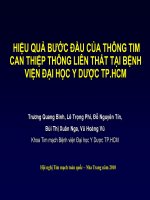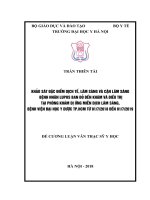ATRIOVENTRICULAR BLOCK , BLOCK NHĨ THẤT ĐỘ 3 ,Đ H Y DƯỢC TP HCM
Bạn đang xem bản rút gọn của tài liệu. Xem và tải ngay bản đầy đủ của tài liệu tại đây (627.74 KB, 12 trang )
COMPLETE (THIRD DEGREE)
ATRIOVENTRICULAR BLOCK
Bộ môn Nhi – ĐH Y Dược TP. HCM
TS. BS. Vũ Minh Phúc
CONTENTS
1. Description
2. Causes
3. Significance
4. Diagnosis
5. Management
1. DESCRIPTION
• Complete Heart Block (CHB) :
atrial and ventricular activities are entirely
independent of each other
• CHB may occur at :
– A-V node
– His bundle
– both bundle branches
– atria-supranodal site
1. DESCRIPTION
• ECG manifestations
– atrioventricular (P : Q) dissociation
– supraventricular rhythm (P waves):
• P waves are regular (regular P-P interval)
• P rate = normal heart rate for the patient’s age
– ventricular rhythm (QRS complex)
• normal QRS
(idionodal rhythm)
abnormal
(idioventricular rhythm)
• ventricular rate (QRS rate) < atrial rate (P rate)
• regular or irregular rhythm
1. DESCRIPTION
• ECG manifestations
2. CAUSES
• Congenital type
– without structure heart defect
– with congenital heart disease (CHD) : corrected TGA
– maternal disease:
SLE, Sjogren’s disease, connective tissue disease
• Acquired type
– cardiac surgery
– myocarditis (virus, bacteria, ARF, Lyme’s disease)
– overdoses of certain drugs (beta blockers, calcium
blockers, digitalis, antiarrhythmic agents, …), toxins
– cardiac tumor
– cardiomyopathies
– myocardial infarction
3. SIGNIFICANCE
• Congestive heart failure (CHF)
– in congenital CHB with CHD : CHF early occur in infancy
– in acquired CHB : myocarditis, intoxication
• Syncopal attacks (Adam-Stokes attacks)
– occur with HR < 40-45 bpm
– sudden onset of acquired CHB
• Asymptomatic child, normal growth and
development , only cardiomegaly on CXR
for 5-10 years in congenital CHB without CHD
3. SIGNIFICANCE
• Key points in examination
– Carefully take the history
– Vital signs (BP, concious level, hypothermia)
– Evidence of congestive heart failure
– Evidence of hemodynamic compromise
4. DIAGNOSIS
• Positive diagnosis based on ECG
• Differential diagnosis : A-V dissociation without CHB
(atrial rate < ventricular rate)
• Determine causes based on:
– history
– clinical picture
– specific test, cardiac imaging
Congenital CHB: normal QRS; ventricular rate is faster
(50-80 bpm), response to varying physiologic conditions
Acquired CHB: abnormal QRS; ventricular rate is low
(40-50 bpm) and is relatively fixed
5. MANAGEMENT
• Congenital type
– asymptomatic CHB, acceptable HR, narrow
QRS complex, normal ventricular function
NO TREATMENT
– PERMANENT PACEMAKER in patients with:
• Symptomatic CHB (dizziness, lightheadness, …)
• CHF
• Infants have
– ventricular rate < 50-55 bpm
– ventricular rate < 70 bpm associated with CHD
• Wide QRS, complex ventricular ectopy, ventricular
dysfunction
5. MANAGEMENT
• Acquired type
– drugs are given during preparation for temporary pacemaker if
patients have CHF or hemodynamic compromise
• Atropin IV
: 0.02 mg/kg
• Isoproterenol IV
: 0.1-0.5 g/kg/min
• Dopamin IV
> 5-20
g/kg/min
• Epinephrine IV
: 0.1-1
g/kg/min
– temporary transvenous ventricular pacing (VVI)
temporary transcutaneous pacing
– permanent pacemaker if CHB does not disappear
• after 2 weeks
in myocarditis, toxication
• after 1 week
in CHB after cardiac surgery









